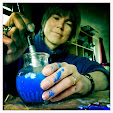In May I again visited the crowded seabird cliffs of Colonsay. An overwhelming number of birds were all pursuing the business of life and survival; choosing a mate, building a nest, finding enough food to raise young. We find these tasks challenging enough ourselves, but we have the help of weather forecasts, GPS and shelter from the elements (not to mention internet dating). How do these birds raise a chick perched on a cliff-face exposed to the Atlantic, and how can they find suitable food in that seemingly featureless expanse of water?
As fulmars wheeled
above me, guillemots squabbled and jostled on ledges next to me, and the calls
of kittiwakes shrieked up from the gullies below, I clung on to the cliff-face.
As an artist I was supposed to be making some sense of this chaos on paper, but my
paints were still in my bag.
That’s when I met Ellie and Tessa, scientists from the RSPB FAME project. They were studying individual birds to uncover some of the mysteries of seabird survival. When they showed me their results, my amazement increased. How could a bird as delicate as a kittiwake travel so far across the waves? How could a bird as small as a razorbill dive so deep below them?
That’s when I met Ellie and Tessa, scientists from the RSPB FAME project. They were studying individual birds to uncover some of the mysteries of seabird survival. When they showed me their results, my amazement increased. How could a bird as delicate as a kittiwake travel so far across the waves? How could a bird as small as a razorbill dive so deep below them?
The FAME girls and I decided to work together. We invited other artists to join us in an exhibition at the Kelvingrove Museum in Glasgow, aiming to share a little of the magic of a seabird colony . By combining art and science we hope to offer a glimpse into that extraordinary world, and unravel some of its mysteries. The exhibition is called "Sea Art Differently" and runs from 13th to 21st October 2012.




No comments:
Post a Comment